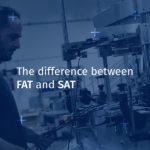The quality and compliance of our packaging machines (fillers, capping machines, and labelers) are essential to ensuring optimal performance for our customers. To achieve this, we follow rigorous qualification procedures to ensure that each installation, operation, and performance meets the required standards and expectations. This qualification process is divided into three key stages: IQ (Installation Qualification), OQ (Operational Qualification), and PQ (Performance Qualification).
IQ: Installation Qualification
Installation Qualification (IQ) is the first phase of the validation process for a filler, capping machine, labeller, or monobloc. The goal is to verify that the machine installation meets the defined specifications and safety standards. The purpose is to ensure that all systems are correctly installed and that the working environment is suitable for the proper functioning of the equipment.
Objectives of IQ:
- Verification of installation compliance: checking alignment, assembly, and electrical, pneumatic, and mechanical connections.
- Environmental condition verification: the machine must be installed in an optimal environment, considering factors such as temperature, humidity, ventilation, etc.
- Validation of equipment integrity: ensuring the machine is in good condition before starting operational tests.
Example with the VS2000 Capping Machine:
When installing the VS2000 capping machine, we check the alignment of components, the strength of pneumatic and electrical connections, and the compliance of the installation environment. We ensure that the machine operates in an area where temperature, humidity, and ventilation are optimized for maximum efficiency.
OQ: Operational Qualification
Once the installation is validated through IQ, the Operational Qualification (OQ) takes over. The goal of OQ is to ensure that the machine functions correctly under real-world operating conditions. This phase includes testing basic functions, start-up and shut-down procedures, and evaluating the system’s response to commands.
Objectives of OQ:
- Operational testing: verifying all machine functions to ensure it responds properly to start-up, shut-down, and other standard operations.
- Alarm and safety system checks: ensuring that safety systems function reliably to protect operators and the equipment.
- Validation of performance under real conditions: performing tests with loads and conditions similar to those in production to confirm the machine’s proper operation.
Example with the E-Fill Monobloc:
For the E-Fill monobloc, we conduct operational tests to verify that the filling and capping system works seamlessly at full capacity. This includes testing the machine’s response during start-up and shut-down processes to ensure smooth operation in real production conditions.
PQ: Performance Qualification
Performance Qualification (PQ) is the final step in the validation process. After installation and operational validation, this phase assesses whether the equipment meets the expected long-term performance. It involves in-depth tests to measure productivity, efficiency, energy consumption, accuracy, and other criteria based on the customer’s requirements.
Objectives of PQ:
- Performance testing: conducting tests to confirm that the machine meets agreed-upon performance specifications, such as speed, capacity, or energy consumption.
- Stability evaluation: ensuring that the machine can operate reliably and consistently over extended periods without failure.
- Adjustment optimization: testing different settings to maximize efficiency under real production conditions.
PQ ensures that the machine continues to perform at the expected level and can sustain continuous, stable production in the long term.
A comprehensive process to ensure quality and reliability
The IQ, OQ, and PQ stages form a complete validation process for our machines. We ensure that every installation not only meets the specifications but also operates reliably, safely, and optimally throughout its lifecycle.
By following these steps, we guarantee maximum performance, minimize the risk of failure, and ensure customer satisfaction by providing reliable equipment tailored to their specific needs.






